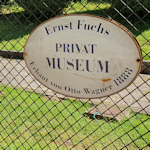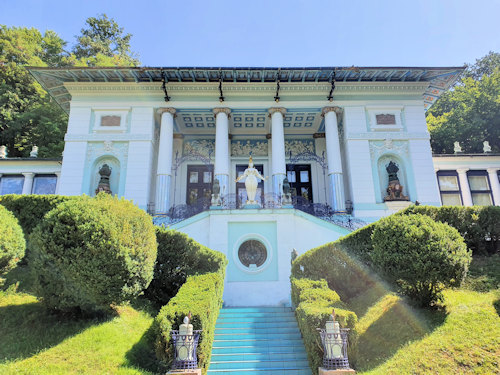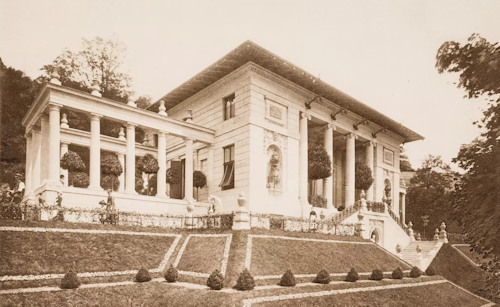
Wander the wooded outskirts of Vienna, and you might come across a beautiful 19th-century palladian villa with garden art installations. Unlike most villas here, you can actually go into this one: it contains the Ernst Fuchs Museum.
- Beautifully-restored home of the cofounder of the Vienna School of Fantastic Realism
- Full of Fuchs’s art, furniture, and interior design
- Wonderful fountain complex out in the gardens
- Otto Wagner built the original villa in the late 1880s
- A little off the beaten path, though
- Book a classical concert experience* for your Vienna trip
- See also:
Discover Ernst Fuchs

(Not your average suburban dwelling)
Ernst Fuchs (1930 – 2015) became famous for his paintings, sculptures, architecture, set designs, drawings, books, and more.
Those works combine eras, epochs, and styles, draw on symbolism, spirituality, and psychology, and run the gamut from simple charcoal drawings to colourful wall paintings and monumental church ceilings.
So, yes, one of those annoyingly multi-talented people who leave you open-mouthed at the breadth and depth of their skills.
A trip to the Ernst Fuchs Museum allows you to dip into the artistic legacy and biography of one of Austria’s most renowned artists, but also to simply enjoy some wonderful works of art, furniture, and interior décor.
Fuchs bought the Otto Wagner Villa that now houses the museum in 1972 and restored it completely, changing much of the interior out of necessity given the dilapidated state of the place.
So, for example, the former billiard room became the Blue Salon, dominated by colourful paintings and a huge bed worthy of Dionysus.

(The Otto Wagner Villa as it was in 1889; Wien Museum Inv.-Nr. 96285/36; excerpt reproduced with permission under the terms of the CC0 licence)
This is not a museal institution in the traditional “cabinet and information displays” sense. Instead, we’re essentially invited to pop into Fuchs’s house, which he has decorated himself.
You start on the top floor in a Roman-style open-plan bathroom. A short(ish) video (in German with English subtitles) explores Fuchs’s life, his art, and his beliefs and motivations. The upper floor also features some of his early works.
The documentary gives you an understanding of Fuchs’s huge imagination, how his works often tie into world events or psychological moments, and how he addresses such themes as mythology, architecture, music, religion, science, landscape, nature, technology, and sexuality in his oeuvre.
(Clearly, Fuchs can’t be described as a one-trick pony.)
The real beauty (in my opinion) emerges in the light-filled rooms of the ground floor, where you might find a simple-looking, classically-lined Fuchs sofa sitting beneath an altarpiece hommage to Albrecht Dürer. See for yourself with this virtual tour.
Little (and large) artistic touches grace the museum grounds, too.
The outdoor highlight comes in the form of the Nymphäum Omega fountain complex, a mosaic of form and colour that defies easy description (at least by me).

(The fountain and gardens)
Tickets & visitor tips
At the time of writing, entry to the Ernst Fuchs Museum costs €14 for an adult.
You might want to precede (or follow) a visit with a wander through the surrounding woods. For example, a hiking path goes around the back of the property and up toward the Jubiläumswarte viewing tower where Johann-Staud-Straße meets the Pelzer Rennweg.
That tower is one of my recommended locations for lovely views across the city.
We tried the walk in early summer. The path took us through a couple of butterfly-filled meadows and gave us some excellent vistas on the way.
How to get to the museum
Just follow the directions given on the Otto Wagner Villa page. The museum is somewhat out the way, up in the wooded hills that bound the west side of Vienna, but accessible by bus from the Hütteldorf station at the western end of the U4 subway line.
Address: Hüttelbergstraße 26, 1140 | Website